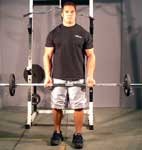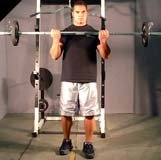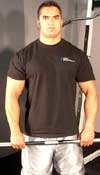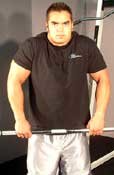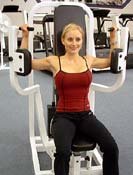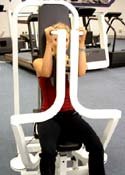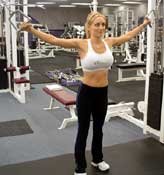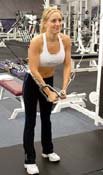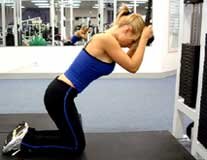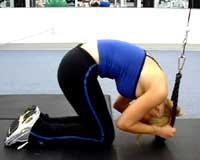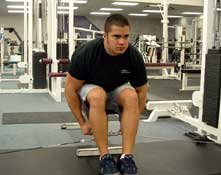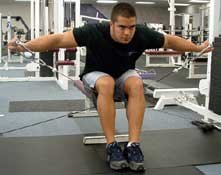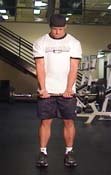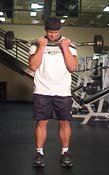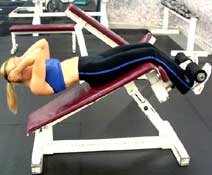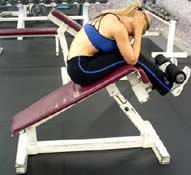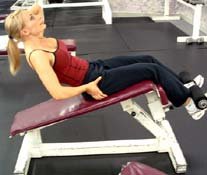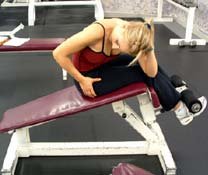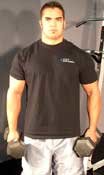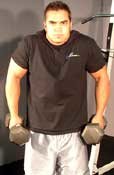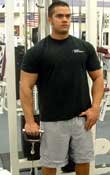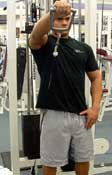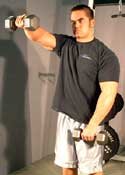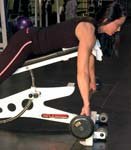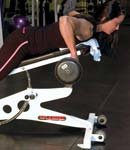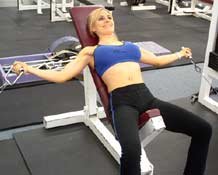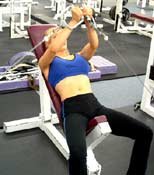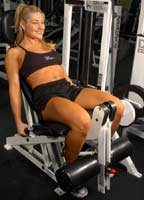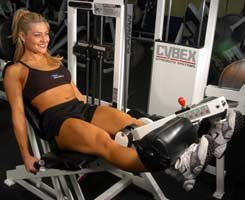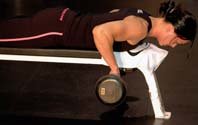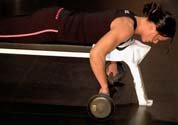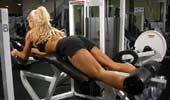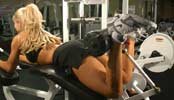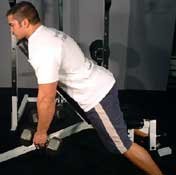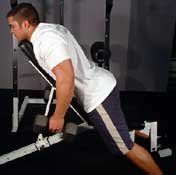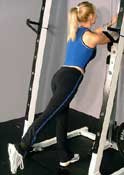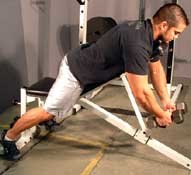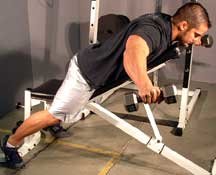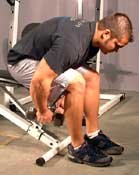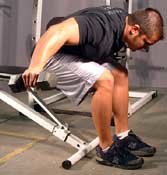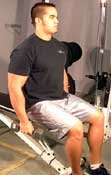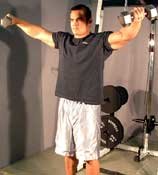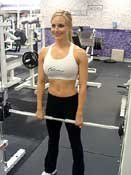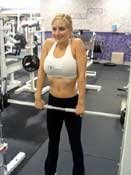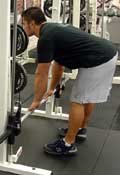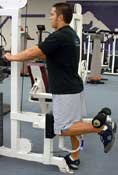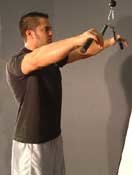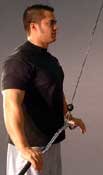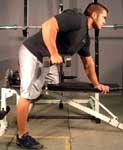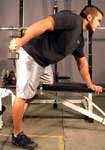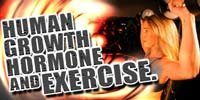
TOPIC: What Is The Best Isolation Workout?

The Question:
Isolation movements are excellent for targeting specific muscles.
What is the best all isolation workout? Be specific.
What is your favorite isolation exercise? Why?
What are some of the benefits of an all isolation workout?
What are some negative aspects of an all isolation workout?
Who would benefit from using an all isolation workout?
Show off your knowledge to the world!
The Winners:
- BurningHeart View Profile
- bigcalves View Profile
New Prizes:
- 1st place - $75 in store credit.
- 2nd place - $50 in store credit.
To use your credit, e-mail Will @ will@bodybuilding.com for more info.

1st Place - BurningHeart
View This Author's BodySpace Account Here.


Introduction
In terms of training, what is the difference between a good bodybuilder and a great bodybuilder? It's not that the great bodybuilder works out longer, with more intensity or with heavier weights. The factor in training that separates the two is that the great bodybuilder has a complete routine. It's a routine that includes isolation work to keep their body in proportion.
Some weightlifters often make the mistake that isolation work is useless and a full compound routine is all one needs to build muscle. While compounds are the quickest way to work your body, they fail to fully exhaust the muscles. This is where isolation work is needed.
While a compound workout is faster, isolations will better target each individual muscle, resulting in a complete workout. This puts more stress on the muscles, and thus makes them grow better than a full compound workout.
Read on and learn why isolations are so important, and how a full isolation routine can actually be a benefit for some people. I will go through the benefits and the negatives of isolation work, and which isolations are best used to gain the most muscle mass.

Question
What Is The Best All Isolation Workout? Be Specific.

The best all isolation workout would be one that targets every muscle only once, in order to be efficient with your time. There is no benefit working the same muscle with more than one exercise per day. Plus for a workout to be the best that it can be, no muscle should be neglected.
The workout will be split into 3 parts over a 12-week period, in order to prevent any muscle adaptation. The first part is designed to be more strength oriented to prepare you for the second half. The second part is designed for size gains. The third part is intense, as it incorporates the benefits of strength and size gains. It is done last in the routine because your body will need days off to recover from the whole routine, especially the third part.
Each workout should not last for more than an hour, as isolation exercises are able to be performed faster and with less rest than compounds.
The whole routine would look like this:
- Weeks 1-5 : Part 1 - Strength Gains
- Weeks 6-10 : Part 2 - Size Gains
- Weeks 6-12 : Part 3 - Intense Size and Strength Gains
- Week 13 : Rest
Repeat
The best all isolation workout would look like this:
 Strength Oriented Isolation Workout - Week 1-5:
Strength Oriented Isolation Workout - Week 1-5:
| Body Part | Monday | Tuesday | Thursday | Friday |
| Abdominals | Decline Crunch | Decline Oblique Crunch | ||
| Back (Lats) | Straight-Arm Pulldown | Straight-Arm Pulldown | ||
| Back (Rhomboids) | Incline Bench Pull | Lying Cambered Row | ||
| Biceps | Barbell Curls | Close Grip EZ-Bar Curl | ||
| Chest | Cable Crossovers | Butterfly | ||
| Triceps | Seated Overhead Tricep Extensions | Tricep Pushdowns | ||
| Delts (Anterior) | Front Dumbbell Raise | Front Cable Raise | ||
| Delts (Lateral) | Side Lateral Raise | Seated Side Lateral Raise | ||
| Delts (Posterior) | Seated Bent Over Rear Delt Raise | Reverse Dumbbell Fly | ||
| Trapezius | Barbell Shrug | Dumbbell Shrug | ||
| Legs (Calves) | Standing Barbell Calf Raise | Smith Machine Reverse Calf Raises | ||
| Legs (Glutes) | One Legged Cable Kickback | One Legged Cable Kickback | ||
| Legs (Hamstrings) | Lying Leg Curls | Standing Leg Curl | ||
| Legs (Quadriceps) | Leg Extensions | Leg Extensions | ||
 Mon. Log. Mon. Log. |
 Tues. Log. Tues. Log. |
 Thurs. Log. Thurs. Log. |
 Fri. Log. Fri. Log. |
|
| Rep/Set Range - 3 Sets, Max Weight for 6 Reps | ||||
 Size Oriented Isolation Workout - Week 6-10:
Size Oriented Isolation Workout - Week 6-10:
| Body Part | Monday | Tuesday | Thursday | Friday |
| Abdominals | Cable Crunch | Decline Oblique Crunch | ||
| Back (Lats) | Straight-Arm Pulldown | Straight-Arm Pulldown | ||
| Back (Rhomboids) | Incline Bench Pull | Middle Back Shrug | ||
| Biceps | Barbell Curls | Close Grip EZ-Bar Curl | ||
| Chest | Cable Crossovers | Incline Cable Fly | ||
| Triceps | Decline Close Grip Bench Press + Skull crushers | Tricep Kickbacks | ||
| Delts (Anterior) | Front Dumbbell Raise | Front Incline Dumbbell Raise | ||
| Delts (Lateral) | Side Lateral Raise | Seated Side Lateral Raise | ||
| Delts (Posterior) | Seated Bent Over Rear Delt Raise | Cable Seated Rear Lateral Raise | ||
| Trapezius | Cable Shrugs | Smith Machine Shrugs | ||
| Legs (Calves) | Standing Dumbbell Calf Raise | Smith Machine Reverse Calf Raises | ||
| Legs (Glutes) | One Legged Cable Kickback | One Legged Cable Kickback | ||
| Legs (Hamstrings) | Lying Leg Curls | Smith Machine Stiff Legged Deadlift | ||
| Legs (Quadriceps) | Leg Extensions | Leg Extensions | ||
 Mon. Log. Mon. Log. |
 Tues. Log. Tues. Log. |
 Thurs. Log. Thurs. Log. |
 Fri. Log. Fri. Log. |
|
| Rep/Set Range - 3 Sets, Max Weight for 15 Reps | ||||
 Size & Strength Oriented Isolation Workout - Week 11 & 12:
Size & Strength Oriented Isolation Workout - Week 11 & 12:
| Body Part | Monday | Tuesday | Thursday | Friday |
| Abdominals | Decline Crunch | Decline Oblique Crunch | ||
| Back (Lats) | Straight-Arm Pulldown | Straight-Arm Pulldown | ||
| Back (Rhomboids) | Incline Bench Pull | Lying Cambered Row | ||
| Biceps | Barbell Curls | Close Grip EZ-Bar Curl | ||
| Chest | Cable Crossovers | Butterfly | ||
| Triceps | Decline Close Grip Bench Press + Skull crushers | Tricep Pushdowns | ||
| Delts (Anterior) | Front Dumbbell Raise | Front Cable Raise | ||
| Delts (Lateral) | Side Lateral Raise | Seated Side Lateral Raise | ||
| Delts (Posterior) | Seated Bent Over Rear Delt Raise | Cable Seated Rear Lateral Raise | ||
| Trapezius | Cable Shrugs | Smith Machine Shrugs | ||
| Legs (Calves) | Standing Barbell Calf Raise | Smith Machine Reverse Calf Raises | ||
| Legs (Glutes) | One Legged Cable Kickback | One Legged Cable Kickback | ||
| Legs (Hamstrings) | Lying Leg Curls | Smith Machine Stiff Legged Deadlift | ||
| Legs (Quadriceps) | Leg Extensions | Leg Extensions | ||
 Mon. Log. Mon. Log. |
 Tues. Log. Tues. Log. |
 Thurs. Log. Thurs. Log. |
 Fri. Log. Fri. Log. |
|
| Set Range - 3 Total Sets, set weight to the maximum possible for 12 reps Rep Range - 4 Reps, Rest 10 seconds * 6 = 24 Total Reps |
||||

Exercise Reference Guide
While all of the following are isolation exercises, they do not only use a single muscle during the exercise. It is rare to find an exercise without more than one muscle being worked in it, whether it is a secondary muscle or a stabilizer assisting the main muscle. The main focus for isolation work is to concentrate fully on using the main muscle to move the weight.
Main Muscles Worked - The muscles that are used the most during the exercise.
Secondary Muscles Worked -Muscles that assist the main muscles in the exercise.
Stabilizers - Muscles that are not worked by movement, but rather assist in stabilizing the body in addition to the weight of the exercise.
 Barbell Curls
Barbell Curls
Main Muscles Worked:
- Biceps Brachii
Secondary Muscles Worked:
- Brachialis
- Brachioradialis
Stabilizers:
- Deltoid, Anterior
- Trapezius, Upper
- Trapezius, Middle
- Levator Scapulae
- Wrist Flexors
What To Do:
- With your hands shoulder-width apart, grip a barbell with an underhand grip.
- Stand straight up with your shoulders squared and with your feet shoulder-width apart.
- Let the bar hang down at arm's length in front of you, with your arms, shoulders and hands in a straight line.
- Without leaning back or swinging the weight, curl the bar up toward your chest in an arc. Keep your elbows in the same place and close to your sides. Bring the weight up as high as you can and squeeze the biceps at the top. Lower the weight slowly, resisting all the way down until your arms are nearly straight.
 Barbell Shrug
Barbell Shrug
Main Muscles Worked:
- Trapezius, Upper
Secondary Muscles Worked:
- Trapezius, Middle
- Levator Scapulae
Stabilizers:
- Erector Spinae
What To Do:
- Hold a barbell with both hands in front of you with your hands a little wider than shoulder width apart. Keep your feet at shoulder width. Stand straight up with the bar hanging at arms length.
- Droop shoulders down as much as possible to start. Raise your shoulders up as far as you can go. Then slowly return to the starting position.
 Butterfly
Butterfly
Main Muscles Worked:
- Pectoralis Major, Sternal
Secondary Muscles Worked:
- Pectoralis Major, Clavicular
- Deltoid, Anterior
Stabilizers:
- None
What To Do:
- Sit at the machine with your back flat on the pad. Place your forearms on padded lever. Position your upper arms approximately parallel to the ground.
- Push levers together slowly and squeeze your chest in the middle. Return until chest muscles are stretched fully. Repeat.
 Cable Crossovers
Cable Crossovers
Main Muscles Worked:
- Pectoralis Major, Sternal
Secondary Muscles Worked:
- Pectoralis Major, Clavicular
- Pectoralis Minor
- Rhomboids
- Levator Scapulae
- Deltoid, Anterior
- Latissimus Dorsi
Stabilizers:
- Biceps Brachii
- Brachialis
- Triceps Brachii
- Wrist Flexors
What To Do:
- Hold the stirrup cable attachments that are attached to a high pulley. Stand about one foot in front of the weight stacks with a handle in both hands.
- Lean slightly forward and put one foot in front of the other (for balance). Your front knee should be slightly bent.
- Bring your hands around and in front of your body in a hugging motion with your elbows slightly bent. You should be pulling down at a slight angle. Focus on using just your chest muscles.
- When your hands meet directly in front of your midsection, squeeze the muscles and then slowly return to the starting position. Your elbows should stay in the same slightly bent position the whole time. Do not walk out too far in front of the pulley system or bend over too much.
 Cable Crunch
Cable Crunch
Main Muscles Worked:
- Rectus Abdominis
Secondary Muscles Worked:
- Obliques
Stabilizers:
- None
What To Do:
- Kneel below a high pulley. Grasp cable rope attachment and place wrists against the head.
- Flex hips slightly and allow the weight to hyperextend the lower back. With the hips stationary, flex the waist so the elbows travel toward the middle of the thighs. Return and repeat.
 Cable Seated Rear Lateral Raise
Cable Seated Rear Lateral Raise
Main Muscles Worked:
- Deltoid, Lateral
Secondary Muscles Worked:
- Deltoid, Anterior
- Supraspinatus
- Trapezius, Middle
- Trapezius, Lower
- Serratus Anterior, Inferior Digitations
Stabilizers:
- Trapezius, Upper
- Levator Scapulae
- Wrist Extensors
What To Do:
- Sit at edge of bench with feet placed beyond knees. Rest torso on thighs.
- Grasp dumbbell cable attachments with opposite hands. Raise upper arms to sides until shoulder height.
- Maintain upper arms perpendicular to torso and a fixed elbow position (10° to 30° angle) throughout exercise. Lower and repeat.
 Cable Shrugs
Cable Shrugs
Main Muscles Worked:
- Trapezius, Upper
Secondary Muscles Worked:
- Trapezius, Upper
Stabilizers:
- Erector Spinae
What To Do:
- Grasp cable bar that is attached to the low pulley with a shoulder width or slightly wider overhand grip. Stand close to pulley.
- Elevate shoulders as high as possible. Lower and repeat.
 Close Grip EZ-Bar Curl
Close Grip EZ-Bar Curl
Main Muscles Worked:
- Biceps Brachii
Secondary Muscles Worked:
- Brachialis
- Brachioradialis
Stabilizers:
- Deltoid, Anterior
- Trapezius, Upper
- Trapezius, Middle
- Levator Scapulae
- Wrist Flexors
What To Do:
- This is like the normal EZ Bar Bicep Curl, but with a closer grip which works the outer part of the biceps more. Grab a cambered EZ Curl bar and hold it on the innermost ridges. Your two hands together should be in the shape of a big V.
- While standing, hold the bar at arm's length in front of you. Curl the bar up while keeping your elbows in the same place. Do not swing! Contract your biceps as far as you can go, and then slowly return to the starting position.
 Decline Close Grip Bench Press + Skull Crushers
Decline Close Grip Bench Press + Skull Crushers
Main Muscles Worked:
- Triceps Brachii
Secondary Muscles Worked:
- Deltoid, Anterior
- Pectoralis Major, Sternal
- Pectoralis Major, Clavicular
Stabilizers:
- Deltoid, Anterior
- Pectoralis Major, Clavicular
- Pectoralis Major, Sternal
- Latissimus Dorsi
- Teres Major
- Deltoid, Posterior
- Wrist Flexors
- Biceps Brachii
What To Do:
- This combines the explosive power of the close grip bench press with the unmatched stretch and concentration when doing skull crushers. Form is extremely important, stress on the eccentric (lowering) portion of the movement and contract at the top of the movement.
- Start with a bench press from the lower chest, then as you lockout, contract and begin lowering for the eccentric portion of the skull-crusher.
- Now raise the barbell again and do the eccentric portion of the bench.
 Decline Crunch
Decline Crunch
Main Muscles Worked:
- Rectus Abdominis
Secondary Muscles Worked:
- Obliques
Stabilizers:
- Tibialis Anterior
What To Do:
- Using a decline bench, position yourself with your feet locked in at the top. Your upper body should be raised off the bench so that you have to contract your abs just to stay in place.
- Place your hands on each side of your head, over your heads. Don't lock your fingers. Raise your body slowly while you contract your abs. Crunch up until your elbows are on either side of your thighs.
- Hold and flex your abs, then slowly lower your body back to the starting position. Don't lower your body all the way down the bench. If you can, hold a weight plate across your chest for added resistance.
 Decline Oblique Crunch
Decline Oblique Crunch
Main Muscles Worked:
- Obliques
Secondary Muscles Worked:
- Iliopsoas
- Tensor Fasciae Latae
- Rectus Femoris
- Sartorius
- Rectus Abdominis
Stabilizers:
- Tibialis Anterior
What To Do:
- Position yourself on a decline bench with your feet locked in. Your upper body should be raised off the bench.
- Cup your right hand over your right ear, and place your left hand on your thigh. Raise your upper body slowly while turning your torso to the left. Focus on keeping your abs tight and keeping the movement slow and controlled.
- Continue crunching up until your right elbow touches your left knee. Lower your body slowly back down to the starting position. After completing one set on the right, switch to your left side.
- TIP: Focus on really twisting your torso and feeling the contraction when you are in the UP position.
 Dumbbell Shrug
Dumbbell Shrug
Main Muscles Worked:
- Trapezius, Upper
Secondary Muscles Worked:
- Trapezius, Middle
- Levator Scapulae
Stabilizers:
- Erector Spinae
What To Do:
- Stand straight up with your feet at shoulder width. Hold two dumbbells with your arms hanging at your sides.
- Droop shoulders down as far as possible. Raise shoulders up as far as you can go. Then slowly return to the starting position.
 Front Cable Raise
Front Cable Raise
Main Muscles Worked:
- Deltoid, Anterior
Secondary Muscles Worked:
- Pectoralis Major, Clavicular
- Deltoid, Lateral
- Trapezius, Middle
- Trapezius, Lower
- Serratus Anterior, Inferior Digitations
Stabilizers:
- Trapezius, Upper
- Levator Scapulae
- Wrist Extensors
What To Do:
- 1. Grasp the cable attachment that is attached to the low pulley with one hand.
- 2. Face away from the pulley and put your arm straight down.
- 3. Keeping your body straight and your elbow nearly locked, raise your arm up in front of your body. Do not swing.
- 4. Go up to about eye level, and then slowly return to the starting position. Finish your reps and then switch arms.
 Front Dumbbell Raise
Front Dumbbell Raise
Main Muscles Worked:
- Deltoid, Anterior
Secondary Muscles Worked:
- Pectoralis Major, Clavicular
- Deltoid, Lateral
- Trapezius, Middle
- Trapezius, Lower
- Serratus Anterior, Inferior Digitations
Stabilizers:
- Trapezius, Upper
- Levator Scapulae
- Wrist Extensors
What To Do:
- Stand with a dumbbell in each hand, palms facing backward. Your feet should be about shoulder width apart. Maintain a slight bend in your elbows throughout the exercise so that your arms are straight, but not quite locked.
- Lift the weight in your left hand in front of you in a wide arc until it is slightly higher than shoulder height.
- With a smooth, controlled motion, lower the weight while simultaneously lifting the weight in your right hand, so that both arms are in motion at the same time. Do not cheat by swinging or leaning backward.
 Front Incline Dumbbell Raise
Front Incline Dumbbell Raise
Main Muscles Worked:
- Deltoid, Anterior
Secondary Muscles Worked:
- Pectoralis Major, Clavicular
- Deltoid, Lateral
- Trapezius, Middle
- Trapezius, Lower
- Serratus Anterior, Inferior Digitations
Stabilizers:
- Trapezius, Upper
- Levator Scapulae
- Wrist Extensors
What To Do:
- Lay down on an incline bench with the incline set anywhere between 30-to-60 degrees.
- Hold two dumbbells with your arms straight and your palms facing down. The dumbbells should start about 1 inch above your thighs.
- Slowly raise the dumbbells straight up until they are slightly above your shoulders, while keeping your elbows locked.
- Squeeze at the top, then lower them to the starting position and repeat. Keep your head resting down against the bench and your legs on the floor.
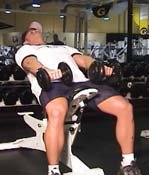
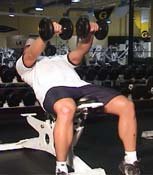
 Click Image To Enlarge.
Click Image To Enlarge. Front Incline Dumbbell Raise.
Video Guide: Windows Media - MPEG - Video iPod
 Incline Bench Pull
Incline Bench Pull
Main Muscles Worked:
- Back, Rhomboids
Secondary Muscles Worked:
- Trapezius, Middle
- Trapezius, Lower
- Latissimus Dorsi
- Teres Major
- Deltoid, Posterior
- Infraspinatus
- Teres Minor
- Brachialis
- Brachioradialis
- Pectoralis Major, Sternal
Stabilizers:
- Biceps Brachii
- Triceps, Long Head
What To Do:
- Lie face down on a bench and place a weighted barbell at the level of your head.
- Place a block of wood under the front part of the bench where your head is to elevate it and hit your back from a different angle.
- Now grab it and pull it up as if you are doing a reverse bench press. Remember to look up and keep your back flexed.
 Incline Cable Fly
Incline Cable Fly
Main Muscles Worked:
- Pectoralis Major, Sternal
Secondary Muscles Worked:
- Pectoralis Major, Clavicular
- Deltoid, Anterior
- Biceps Brachii, Short Head
Stabilizers:
- Biceps Brachii
- Brachialis
- Triceps Brachii
- Wrist Flexors
What To Do:
- This is like the flat bench fly, except you are lying on a low incline bench (about 30 degrees). Hold the handles above the top portion of your chest with your arms almost straight. You should keep a slight bend in them.
- Slowly lower the handles in a wide arc to shoulder level and then return to the starting position along the exact same path.
- Keep tension on your pecs throughout the movement and squeeze hard at the top.
 Leg Extensions
Leg Extensions
Main Muscles Worked:
- Quadriceps
Secondary Muscles Worked:
- None
Stabilizers:
- Trapezius, Upper
- Trapezius, Middle
- Levator Scapulae
What To Do:
- Using a leg extension machine, sit in the seat and hook your feet under the padded bar. Adjust the pad and/or the seat so that your knees hang off the end of the seat and the footpad rest on the lowest part of the shins.
- Grasp the handles on the machine or the edges of the seat to keep your hips from lifting up as you perform the exercise.
- Extend your legs until knees are straight, making sure you remain seated flat on the machine. Raise the weight all the way, lock and hold briefly, then slowly lower the weight back to the starting position.
- Get the full range of motion and feel the muscle being worked during the entire movement. Do not swing the weight up.
 Lying Cambered Row
Lying Cambered Row
Main Muscles Worked:
- Back, Rhomboids
Secondary Muscles Worked:
- Trapezius, Middle
- Trapezius, Lower
- Latissimus Dorsi
- Teres Major
- Deltoid, Posterior
- Infraspinatus
- Teres Minor
- Brachialis
- Brachioradialis
- Pectoralis Major, Sternal
Stabilizers:
- Biceps Brachii
- Triceps, Long Head
What To Do:
- Lie face down on an exercise bench. The cambered bar should be underneath of the bench.
- Grab a hold of the bar and row it up to your chest (upper back). Lower back down to the start position. A regular barbell can be used, but a cambered barbell gives you a greater range of motion.
 Lying Leg Curls
Lying Leg Curls
Main Muscles Worked:
- Hamstrings
Secondary Muscles Worked:
- Gastrocnemius
- Sartorius
- Gracilis
Stabilizers:
- Tibialis Anterior
- Iliopsoas
- Tensor Fasciae Latae
What To Do:
- Lie face down on a leg-curl machine and hook your heels under the roller pad. Your legs should be stretched out straight so that the pads rest on the back of your ankles.
- Grasp the handles under the bench for support. Remaining flat on the bench, curl your legs up until your hamstrings are fully contracted. Release and lower the weight slowly back to the starting position.
- Concentrate on using a full range of motion and do not swing the weight up. You can point your toes to intensify the burn in your hamstrings.
 Middle Back Shrug
Middle Back Shrug
Main Muscles Worked:
- Back, Rhomboids
Secondary Muscles Worked:
- Trapezius, Middle
- Trapezius, Lower
- Latissimus Dorsi
- Teres Major
- Deltoid, Posterior
- Infraspinatus
- Teres Minor
- Brachialis
- Brachioradialis
- Pectoralis Major, Sternal
Stabilizers:
- Biceps Brachii
- Triceps, Long Head
What To Do:
- To do this exercise, lie facedown on an incline bench. Grab two dumbbells.
- Now, rather than shrug them, as the name implies, squeeze your shoulder blades together and hold the contraction for a full second. It's nothing more than the reverse action of a hug, or trying to perform rear laterals as if you had no arms. The effect is an amazing pump, as this is probably the first time in your life these muscles will have received direct work.
 One Legged Cable Kickback
One Legged Cable Kickback
Main Muscles Worked:
- Gluteus Maximus
Secondary Muscles Worked:
- Hamstrings
Stabilizers:
- Erector Spinae
- Obliques
- Gluteus Medius
- Gluteus Minimus
What To Do:
- Hook a leather ankle cuff to a low cable pulley and then attach the cuff to your ankle. Face the weight stack from a distance of about two feet, grasping the steel frame for support.
- While keeping your knees and hips bent slightly and your abs tight, contract your glutes to slowly "kick" the working leg back in a semicircular arc as high as it will comfortably go.
- At full extension, squeeze your glutes for peak contraction. Bring your working leg forward, resisting the pull of the cable until you reach the starting position.
- After completing the desired number of reps, switch legs and repeat this movement for the other bun.
 Reverse Dumbbell Fly
Reverse Dumbbell Fly
Main Muscles Worked:
- Deltoid, Posterior
Secondary Muscles Worked:
- Infraspinatus
- Teres Minor
- Deltoid, Lateral
- Trapezius, Middle
- Trapezius, Lower
- Rhomboids
Stabilizers:
- Triceps Brachii
- Wrist Extensors
What To Do:
- Set an incline bench at the lowest possible angle. Then, with a dumbbell in each hand, lie face down on the bench so that the top of the bench is supporting your chest.
- Extend your arms in front of you so that they are perpendicular to the angle of the bench. Your palms should be facing each other and your elbows should be slightly bent.
- Maintaining the slight bend in your elbows, lift the weights by pulling your arms apart in an arcing motion. Think about trying to squeeze your shoulder blades together.
- Continue moving your elbows up until the dumbbells are at either side of your head. Slowly return to the starting position.
 Seated Bent-Over Rear Delt Raise
Seated Bent-Over Rear Delt Raise
Main Muscles Worked:
- Deltoid, Posterior
Secondary Muscles Worked:
- Infraspinatus
- Teres Minor
- Deltoid, Lateral
- Trapezius, Middle
- Trapezius, Lower
- Rhomboids
Stabilizers:
- Triceps Brachii
- Wrist Extensors
What To Do:
- Hold two dumbbells and sit at the end of a flat bench with your feet firmly on the floor and fairly close together.
- Bend forward until your chest nearly touches your thighs. Hang dumbbells between your lower legs and bench. Keep your arms straight and your elbows nearly locked.
- Raise dumbbells in a semicircular motion until your arms are parallel to the floor, even with your ears. Return slowly to starting position. Do not swing.
 Seated Overhead Tricep Extensions
Seated Overhead Tricep Extensions
Main Muscles Worked:
- Triceps Brachii
Secondary Muscles Worked:
- None
Stabilizers:
- Deltoid, Anterior
- Pectoralis Major, Clavicular
- Wrist Flexors
What To Do:
- Hold barbell or EZ Curl bar with your hands about 6-to-8 inches apart. Sit at the end of a flat bench with your feet firmly on the floor and your back straight.
- Raise the bar overhead to arm's length. Lower bar behind your head in a semicircular motion until your forearms touch your biceps.
- Return to starting position. Your elbows and upper arms should never move.
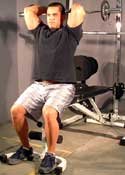
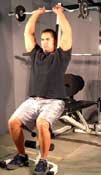
 Click Image To Enlarge.
Click Image To Enlarge. Seated Overhead Tricep Extensions.
Video Guide: Windows Media - MPEG - Video iPod
 Seated Side Lateral Raise
Seated Side Lateral Raise
Main Muscles Worked:
- Deltoid, Lateral
Secondary Muscles Worked:
- Deltoid, Anterior
- Supraspinatus
- Trapezius, Middle
- Trapezius, Lower
- Serratus Anterior, Inferior Digitations
Stabilizers:
- Trapezius, Upper
- Levator Scapulae
- Wrist Extensors
What To Do:
- Sit at the end of a flat bench with your feet firmly on the floor. Hold dumbbells with your palms facing in and your arms straight down at your sides.
- Raise dumbbells in a semicircular motion a little above shoulder height. Slowly lower to the starting position using the same path. Do not swing. Keep your arms straight.
 Side Lateral Raise
Side Lateral Raise
Main Muscles Worked:
- Deltoid, Lateral
Secondary Muscles Worked:
- Deltoid, Anterior
- Supraspinatus
- Trapezius, Middle
- Trapezius, Lower
- Serratus Anterior, Inferior Digitations
Stabilizers:
- Trapezius, Upper
- Levator Scapulae
- Wrist Extensors
What To Do:
- Stand upright, with your feet about shoulder width apart and your arms to your sides. Hold a dumbbell in each hand, with your palms turned toward your body.
- Keeping your arms straight, lift the weights out and up to the sides until they are slightly higher than shoulder level. Then slowly lower them to your sides.
- It's important to keep your palms turned downward as you lift the dumbbells so that your shoulders, rather than your biceps, do the work.
- Make sure you lift the dumbbells on the way up rather than "swinging" them up. Don't lean forward. Keep the dumbbells at your sides.
 Smith Machine Reverse Calf Raises
Smith Machine Reverse Calf Raises
Main Muscles Worked:
- Tibialis Anterior
Secondary Muscles Worked:
- None
Stabilizers:
- None
What To Do:
- 1. To do Smith-machine reverse calf raises, position the bar high enough on the rack so it can lie comfortably on the shoulders.
- 2. Use a platform to stand on; the same you'd use for normal raises, but instead of keeping your heels on the floor, this time the toes start on the floor with heels elevated onto the platform. Align the platform so it is inline with the bar. If you put it forward/back, it will emphasize higher or lower on the calf. Similarly, the stance you use can affect where it hits; the closer your feet are, the sides will hit isolated, whereas the farther apart feet are, the more front tibialis will hit.
- 3. From there you will push down with your heel, the opposite of pushing up with your arch for calf raises.
 Smith Machine Shrugs
Smith Machine Shrugs
Main Muscles Worked:
- Trapezius, Upper
Secondary Muscles Worked:
- Trapezius, Middle
- Levator Scapulae
Stabilizers:
- Erector Spinae
What To Do:
- Stand grasping Smith bar with shoulder width or slightly wider overhand grip. Disengage bar from the rack.
- Elevate shoulders as high as possible. Lower and repeat.
 Smith Machine Stiff-Legged Deadlift
Smith Machine Stiff-Legged Deadlift
Main Muscles Worked:
- Hamstrings
Secondary Muscles Worked:
- Erector Spinae
- Gluteus Maximus
- Adductor Magnus
Stabilizers:
- Trapezius, Middle
- Rhomboids
- Latissimus Dorsi
- Trapezius, Upper
- Levator Scapulae
- Trapezius, Lower
What To Do:
- Bend at your waist with your head up, back straight and knees nearly locked. Hold bar with hands about 16 inches apart.
- Straighten up while holding the bar at arm's length. Lower back down to the floor but do not let plates touch.
 Standing Barbell Calf Raise
Standing Barbell Calf Raise
Main Muscles Worked:
- Gastrocnemius
Secondary Muscles Worked:
- Soleus
Stabilizers:
- None
What To Do:
- Set a barbell on a power rack and put a block of wood or something similar nearby.
- Position your back under the barbell with both hands to sides, just like if you were doing squats. Position your toes and balls of feet on the block with arches and heels extending off and resting on the floor.
- Raise your heels by extending ankles as high as possible. Lower heels by bending your ankles until your calves are stretched. Repeat.
- Keep your knees straight throughout exercise or bend knees slightly only during stretch.
 Standing Leg Curl
Standing Leg Curl
Main Muscles Worked:
- Hamstrings
Secondary Muscles Worked:
- Gastrocnemius
- Gracilis
- Sartorius
- Iliopsoas
- Tensor Fasciae Latae
Stabilizers:
- Rectus Femoris
- Gluteus Medius
- Gluteus Minimus
What To Do:
- Using a standing leg curl machine, keep your body erect at all times and do not bend over. Using one leg, position the pad so it is at your ankle.
- Grab the handles with your hands to stabilize yourself. Pull up with your hamstring and go up as far as you can.
- Do not use momentum to swing the weight up. Perform the desired reps and then do the other leg.
 Straight-Arm Pulldown
Straight-Arm Pulldown
Main Muscles Worked:
- Latissimus Dorsi
Secondary Muscles Worked:
- Pectoralis Major, Sternal
- Triceps, Long Head
- Teres Major
- Deltoid, Posterior
- Rhomboids
- Levator Scapulae
- Pectoralis Minor
Stabilizers:
- Triceps Brachii
- Pectoralis Major, Clavicular
- Rectus Abdominis
- Obliques
- Wrist Flexors
What To Do:
- Stand in front of a lat pulldown bar with your arms outstretched toward the bar. Place your palms flat on the bar and pull it down to shoulder level.
- Keeping your elbows slightly bent and your wrists locked; pull the bar down toward your body in an arcing motion.
- Once you contracted the lats fully and the bar has touched or come close to your thighs, slowly allow the bar to come back up to the starting position. Keep your torso erect.
 Tricep Kickbacks
Tricep Kickbacks
Main Muscles Worked:
- Triceps Brachii
Secondary Muscles Worked:
- None
Stabilizers:
- Deltoid, Posterior
- 2. Latissimus Dorsi
- 3. Trapezius, Middle
- 4. Trapezius, Lower
- 5. Rhomboids
- 6. Extensor Carpi Ulnaris
- 7. Flexor Carpi Ulnaris
What To Do:
- Stand to the right of a flat bench. Bend your left knee and rest it on the bench, and place your left hand ahead of you on the bench for balance. Your back should be as straight as possible.
- Pick up a dumbbell in your right hand. Bend your arm and raise your elbow up to shoulder height. Make sure the elbow stays close to the side of your body. Let the dumbbell hang. Press the weight back until your forearm is parallel to the floor. Squeeze your tricep and then slowly return to the starting position.
- Finish one set, then switch sides and arms. Only your upper arm should move ... not your elbow. Look straight ahead at all times.
 Tricep Pushdowns
Tricep Pushdowns
Main Muscles Worked:
- Triceps Brachii
Secondary Muscles Worked:
- None
Stabilizers:
- Latissimus Dorsi
- Teres Major
- Deltoid, Posterior
- Pectoralis Major, Sternal
- Pectoralis Minor
- Trapezius, Lower
- Rectus Abdominis
- Obliques
- Wrist Flexors
What To Do:
- Using a high-cable pulley, grasp a short straight bar with an overhand grip. Your hands should be about 10 inches apart. Position your forearms so they are parallel to the floor.
- Keep your feet shoulder width apart and bend your knees slightly. Keep your elbows locked in close to your body and your wrists straight. Keep your whole body steady, push the bar down as far as possible toward your legs, locking your arms and feeling the triceps full contract. Keep the upper arms close to the body.
- Return to the starting position using the same motion. Never move your elbows or torso. Stay standing straight up.
A lot of exercises and muscles were mentioned here. Most of them you've heard of before, but for the ones that may sound strange and you want to learn more about, a complete list of muscles written in this article can be found at this link. A complete list of exercises written in this article can be found at this link.

Nutrition Section Of The Workout
As with any workout routine, the proper nutrition is required to feed your body the nutrients it needs to properly repair itself and build muscle after a workout. Creatine is a widely popular and recommended supplement to take, along with a post workout protein shake. Multivitamins are also strongly recommended to replenish your body with needed vitamins and minerals that you may not get enough or any at all during the day.
 Fat:
Fat:
Healthy fats are required in a bodybuilding diet because they aid in maintaining healthy hair and skin, promoting healthy cell function, function in energy storage and vitamins A, D, E, and K can only be digested and used by the body in the combination with fats. Healthy fats include such foods as olive oil, flax seeds and nuts. Fats should equal 20-25% of your total caloric intake.
 Protein:
Protein:
At least 1 gram of protein per pound of bodyweight is recommended for a weightlifting routine, protein aids in the building and repairing of your muscles. Healthy forms of protein include fish, lean red meat, poultry, protein shakes, eggs and skim milk. Protein should equal 35-40% of your total caloric intake.
| PROTEIN CALCULATOR |
 Carbohydrates:
Carbohydrates:
Carbs aid in the immediate usage of energy. Carbs require less water to digest than fat and proteins; therefore they are the most commonly used energy source in the body. Healthy forms of carbohydrates would be foods such as wheat bread, brown rice, oatmeal and nuts. Carbohydrates should equal 40-45% of your total caloric intake.
 Calories:
Calories:
Total calories can be roughly calculated by multiplying your body weight times 15. Then consider these factors:
If Bulking:
Consume 6-8 balanced meals with a total of 500-1000 excess calories.
If Cutting:
Consume 6-8 small balanced meals with a total deficit of 500-1000 calories.
| BULKING/CUTTING CALORIES CALCULATOR |
 Sleep:
Sleep:
The right amount of sleep is also needed, 7-8 straight hours is required to repair your muscles adequately and for your CNS (Central Nervous System) to recover.
 |
The Central Nervous System.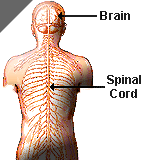 The human central nervous system consists of the brain and spinal cord. These lie in the midline of the body and are protected by the skull and vertebrae respectively. The human central nervous system consists of the brain and spinal cord. These lie in the midline of the body and are protected by the skull and vertebrae respectively.
This collection of billions of neurons is arguably the most complex object known. The central nervous system along with the peripheral nervous system comprise a primary division of controls that command all physical activities of a human. Neurons of the central nervous system affect consciousness and mental activity while spinal extensions of central nervous system neuron pathways affect skeletal muscles and organs in the body. |
 |
 |
||
Also avoid drinking anything 2 hours before you go to sleep, use the bathroom right before bedtime, cut out all lights in the room, loosen and relieve any pressure you may have on your bladder before bed, do not take a nap in the day and relax yourself, as to not worry about any days' events.

Question
What Is Your Favorite Isolation Exercise? Why?

Hands down, my favorite isolation exercise is smith machine shrugs. I like it the best for a number of reasons. One reason is that using the smith machine for shrugs eliminates the need for balancing the bar. This is a great help as your body, forearms especially, can hold the bar up longer because of the support. This allows you to totally concentrate on lifting the weight with your traps.
The Smith machine also has the perfect slant to it. This slant gives you a little more range of motion than you would have with just a barbell. This is because when using a barbell you cannot put your legs slightly past the barbell and slightly arch your back backward. On a smith machine this is possible, thus making the exercise safer and more efficient.
Another reason the smith machine shrug is my favorite exercise is because I see the most benefit from it. It is the best mass builder out of both isolation and compound work for your traps. It's awesome to be able to flex your huge traps gotten from the Smith machine shrugs. I believe traps are one of the most noticed muscles on someone, even with their clothes on, and a much needed muscle to complete your physique.

Question
What Are Some Of The Benefits Of An All Isolation Workout?

 Completely Exhausting A Muscle:
Completely Exhausting A Muscle:
- This is the most well-known benefit of isolation work. Compounds work multiple muscles at once, yet it is impossible to work each of those muscles to its max with a single compound exercise. One muscle will tire out before the other. Thus the only way to get a complete workout with compounds would be to do a compound exercise for every muscle in your body. And that is not feasible due to energy and time.
- This is where isolation work shines, each muscle can be worked to its maximum potential that does not take an extreme amount of time or more energy than one has.
 Less Opportunities For Injuries:
Less Opportunities For Injuries:
- Injuries can arise in all types of workouts, but they are much less common in isolation exercises. This being because compounds are more intense than isolations. They use several muscles in conjunction at once, which greatly opens the door for one muscle overpowering another, thus resulting in a pulled muscle. Another reason is often compounds require you to place great strain on your body.
- Examples are the "Big 3": squats, deadlifts and bench press. Squats and deadlifts put a great deal of pressure on your spinal column while bench press puts pressure on your chest and shoulders at once, often contributing to a pulled muscle if the barbell slips.
 Targeting Every Muscle:
Targeting Every Muscle:
- There are some muscles that you would actually have to work longer and harder just to hit with compound exercises. This is where isolation work helps, it enables you to work a muscle that is hard to hit with compounds.
- An example of this would be calves. With only using compound workouts, one would have to perform extra sets of squats or lunges to target the calves. Then even at that point they would not get worked nearly as much as a few simple sets of calf raises.
 Bringing Up A Lagging Body Part:
Bringing Up A Lagging Body Part:
- Part of being a bodybuilder is having the ability to have your muscles in proportion to each other. Add in the fact that if a certain body part overpowers another, you are opening yourself up for an injury. Plus the fact that your body grows in proportion to itself, meaning it will be harder for the rest of your body to grow if you have some body parts lagging. Isolation work allows you to target a specific muscle if it is lagging behind, in order to build it up to match your other muscles.

Question
What Are Some Negative Aspects Of An All Isolation Workout?

 Slower Strength Gains Compared To Compounds:
Slower Strength Gains Compared To Compounds:
- Compound exercises use multiple muscles at once combined with the movement along two or more joints. When your muscles work in conjunction with each other, it better conditions them for strength gains. This is why powerlifters mainly just do compound work. Isolation exercises do not work multiple muscles at once the way compounds do, which is the reason for slower strength gains when doing isolations.
- Also isolation exercises are not normal movements for our body for the most part. A straight-arm pull-down, which works your lats, is rarely ever used in real life. However a pull-up, which also works your lats, is used in real life for such things as hoisting yourself on to something. The same principle applies to leg extensions, which work your quads. Rarely will you ever do something in real life that resembles a leg extension. However a squat, which also works your quads, is used many times a day for standing yourself up.
 Longer Workouts:
Longer Workouts:
- The isolation benefit for a more complete workout does have a price. An isolation workout will last a good deal longer than a compound workout due to the fact that a separate set must be done for every body part. In a compound workout you may work three muscles at the same time, combining muscles in 1 workout.
 More Effective Exercises For Some Body Parts:
More Effective Exercises For Some Body Parts:
- Even though for the most part isolations will work a muscle better than compounds, there are some exceptions. Squats are an example. No matter how many sets of leg extensions you do, they will not equal up to a few sets of squats. Squats put constant resistance on your quads the entire time, and use your entire legs to hoist the weight back up. Leg extensions only require you to push weight up with just your quads and they do not place a constant resistance on your legs like squats do.

Question
Who Would Benefit From Using An All Isolation Workout?

The people who gain the most benefit from an all isolation workout would definitely be bodybuilders. Bodybuilding competitions are not judged by the competitor's strength or time spent in the gym. Isolation work is required to keep your body in symmetry. A bodybuilder can build an outstanding physique with only isolation work. No other weightlifter or athlete can benefit more from an all isolation workout.
While bodybuilders have the most benefit, there are others who would benefit from an all isolation workout. These would be older people who may not have the strength or bone support to do squats, deadlifts, bench presses, or pullups. Also for the inexperienced weightlifters, who may not know correct form for the big compound exercises or have enough strength to perform them, would benefit from an all isolation routine.
There are not many people that can do pullups on their first day in the gym or can do a set of squats in proper form. An isolation workout would give these people an introduction to weightlifting before they start doing the more advanced exercises. Whatever the reason, an all isolation routine has its place in weightlifting.
That concludes my article. I hope everyone has enjoyed it and gained some knowledge that you may have not known. I also expect my article to open the people's minds who believe isolation work is useless; so they realize that isolation work can and should be included in your routine to complete it.
 References:
References:

2nd Place - bigcalves
View This Author's BodySpace Account Here.


Introduction
Isolation movements are excellent for targeting specific muscles. They are used in order to develop a muscle to its fullest potential. Take the biceps for example. You can do countless pullups and barbell rows that will hit your biceps somewhat, but if you crave for that extreme muscle development you must do curls and isolation movements that will hit them to the max and in return give you super-man arms.
To sum it all up, isolation movements are exercises that target one muscle and work little to no secondary muscle groups.

Question
What Is The Best All Isolation Workout? Be Specific.

Compound movements are a smart part of every routine. But without isolation bodybuilders and even power lifters won't be as strong or as muscularly developed as they are. Isolation movements are important in a workout routine.
I believe that in order to achieve the maximum size possible, one must include compound movements such as squats and deadlifts into their workout. But sometimes people have injuries or are rehabilitating and are unable to. This is where this all isolation workout comes in. If you are feeling over-trained or too sore you can also do this workout and take a break from compounds.
 The Split
The Split
- Monday - Arms, Abs
- Tuesday - Shoulders, Traps
- Wednesday - Legs
- Thursday - OFF
- Friday - Chest
- Saturday - Back
- Sunday - OFF

The Routine 
 Monday:
Monday:
Concentration Curls: 4x 8 8 8 8
Single-Hand Triceps Pushdown: 4x 8 8 8 8
Dumbbell Curls: 4 x 8 8 8 8
French Press: 4x 8 8 8 8
Weighed Crunches: 4x 15 15 12 12
5 Minute Stretching
 Click Here For A Printable Log Of Monday.
Click Here For A Printable Log Of Monday.
 Tuesday:
Tuesday:
Arnold Press: 4x 8 8 8 8
Cable Side Lateral Raises: 4x 8 8 8 8
Cable Front Raises: 4x 8 8 8 8
Shrugs: 6x 20 20 15 15 12 10
10 Minute Stretching
 Click Here For A Printable Log Of Tuesday.
Click Here For A Printable Log Of Tuesday.
 Wednesday:
Wednesday:
Leg Extensions: 6x 20 20 15 15 12 12
Leg Curls: 6x 20 20 15 15 12 12
Hack Squats: 4x 12 12 12 12
Machine Calve Raises: 6x 20 20 20 15 15 10
20 Minute Stretching
 Click Here For A Printable Log Of Wednesday.
Click Here For A Printable Log Of Wednesday.
 Thursday:
Thursday:
- OFF
 Friday:
Friday:
Incline Dumbbell Press: 6x 15 12 12 10 10 8
Isolation Flyes: 4x 10 10 8 8
Cable Cross Overs: 4x 12 12 10 10
Decline Dumbbell Press: 3x 10 10 10
 Click Here For A Printable Log Of Friday.
Click Here For A Printable Log Of Friday.
 Saturday:
Saturday:
Lat Pulldowns: 4x 10 10 8 8
Barbell Rows: 4x 10 10 10 10
Dumbell Row: 2x 10 10
Isolation Cable Rows: 4x 10 10 10 10
 Click Here For A Printable Log Of Saturday.
Click Here For A Printable Log Of Saturday.
 Sunday:
Sunday:
- OFF

Question
What Is Your Favorite Isolation Exercise? Why?

My favorite isolation exercise is the concentrated bicep curl. It's one of my favorites for numerous reasons. First off, that's the very first exercise that hooked me on bodybuilding. I was watching Pumping Iron and when the scene where Arnold was performing the exercise came up I froze.
All I could remember was his huge arms and a vein the thickness of an electrical cord going down them. I was stunned. I wanted to look like that!
Aside from that, this exercise delivers great blood flow to the muscles and in return gives me a great pump. It makes the arms expand and it stretches out the muscle fibers. It's a great exercise that should be in everybody's arm routine. It delivers solid gains and it's fun for me to add weight as I progress. I remember that I started out with only 20 pounds but now I'm up to a solid 50-pound dumbbell and it keeps climbing!

Question
What Are Some Of The Benefits Of An All Isolation Workout?

The best benefit delivered from an all isolation workout is the results! Put in simpler terms, it will give you maximum muscle growth. When body parts are neglected they won't be able to grow. Isolation movements give you the ultimate edge. You get to hit the muscle group that couldn't be hit with compound movements, or it wasn't hit as good and that's why it's lacking.
Take calves for example. Many people suffer from the 'chicken leg syndrome.' Even if their quads and hammies are developed excellently, their calves look like toothpicks. Many will complain that their genetics suck, or that they haven't played soccer when they were youngsters and that's why their calves aren't developed.
If you ask them what they do many will give you their leg routine: squats, leg presses, extensions, curls and maybe 2-4 sets of calve raises at the end, maybe. That's where the problem lies folks. You can't get big calves by doing squats. Unless you are genetically gifted in that area you must isolate the calves with a decent amount of sets. That's where isolation workouts come in, and that's when results happen!

Question
What Are Some Negative Aspects Of An All Isolation Workout?

 Less Power
Less Power
- If you are performing an all isolation workout all the time you won't have the chance to experience the great results that come from compound movements such as squats and deads. By doing so your body won't be as powerful as it could have been. As you increase your squat or dead your total body strength also shoots up, and that's a big thing to miss.
 Less Muscle
Less Muscle
- Isolation workouts are perfect for putting the finishing touches or making that stubborn body part grow. But if you are not taking advantage of compound movements you won't be able to get as big as your body could have been. Exercises such as squats will make your whole body grow because they put tremendous stress on a lot of muscle groups at once. More stress means more muscle fibers being torn, which translates to more total muscle gained.
 HGH (Human Growth Hormone)
HGH (Human Growth Hormone)
- As you put tremendous stress on your body by having a lot of compound lifts your body releases more
- to build up the muscle. In return you will feel more energized, you will recover way faster than before, and most importantly your body will grow. If you follow an all isolation workout all the time you won't be able to cause that much stress on your body for that rich supply of natural HGH.
| RELATED ARTICLE | ||
|
 Weaker Joints
Weaker Joints
- Since you won't be doing any compound lifts your joints, tendons and ligaments won't be under any big stress. As you progress with the isolation movements you will get stronger muscles without having your joints and tendons catch up to the level where you muscle is at. With that being said the chances of
- of when you do attempt to do compound lifts get very high.

Question
Who Would Benefit From Using An All Isolation Workout?

Bodybuilders are the first on the list that can benefit from an all isolation workout. The reason is simple. When competing, bodybuilders must display a high level of muscularity. In order to do that every body part must be developed. You cannot develop everything perfectly just from compound lifts alone, and that's where isolation work comes in to play.
By isolating each muscle you can get it to grow to its maximal potential and in return be very muscularly developed. Body parts such as calves, rear delts and biceps are examples of what can happen when isolation exercises are allowed in the routine.
Along with bodybuilders many athletes can benefit from an all isolation workout. Every athlete has a sport in which one body part is used more often than the others. By isolating that and making that muscle even stronger and more developed an athlete increases the odds of being better than the opponent.
An example of this is a basketball player with huge calves that increase his/her vertical jump or an baseball player with bigger and stronger forearms for the ultimate grip.
In conclusion, isolation workouts are important and should be in everybody's routine! It will help bring up all the lacking parts that you couldn't grow otherwise and maximize your muscle potential.
Good Luck!



